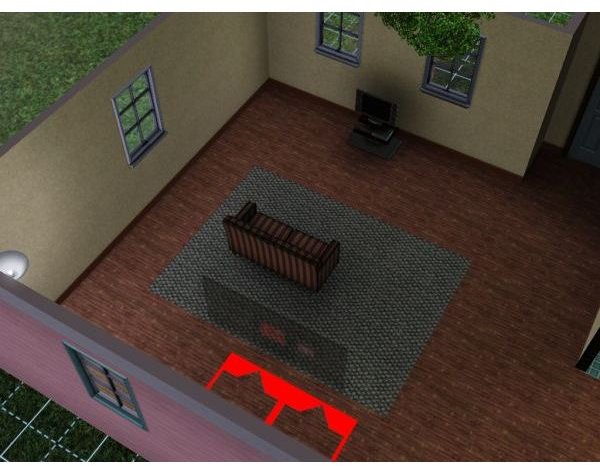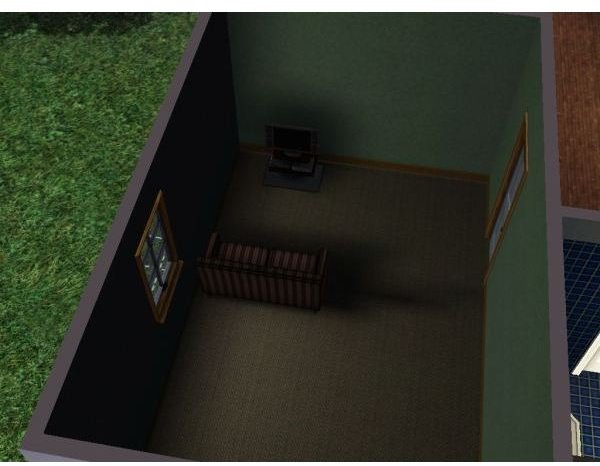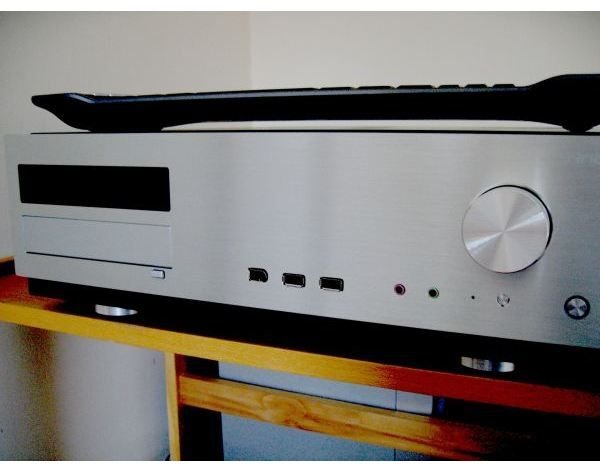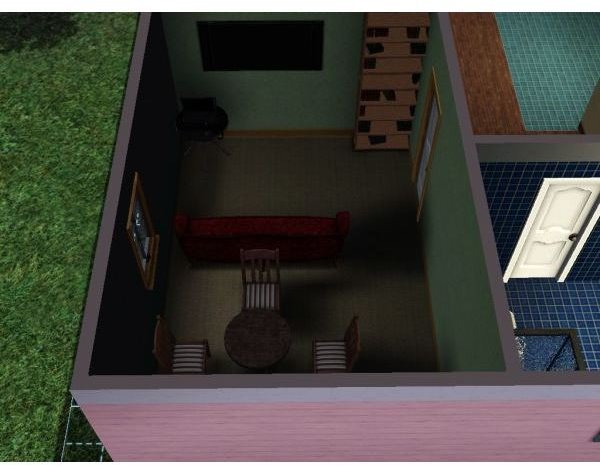Advice on Game Room Design: Location and Seating

In The Hall of the Media King
Electronic gaming - heck, gaming, television, music and more, really - is a rather intimate and personal affair for folks, doubly so considering some of the things you see in games nowadays. While the living room might offer you all the necessities of gaming, its centralized location can be problematic: noise pollution, people coming and going, and the division of television usage are just a few issues you’ll have to deal with. For folks whose one and true passion is gaming and electronic media, finding a space to call your own - be it a game room, a “study”, a man-cave, or whatever other term you’d like to use - is essential.
Location, Location, Location
Setting up a game room isn’t just a matter of dragging your console, PC and all other manner of stuff off to some corner of the house - if only it were that easy! When you’re dealing with a chimera of television sets and game consoles and speakers and goodness knows what else, you’ve got to take special consideration of just where you’re setting this all up. Many factors come into play when it comes to getting the most out of a game room, and game room design requires quite a bit of forethought and consideration.
First and foremost, consider the issue of privacy, both for folks IN the room and folks OUTSIDE the room. The less stuff that can creep into your peripheral vision, the less stuff that can distract you in the heat of gameplay. Meanwhile, the more secluded a game room is from the rest of the house, the less that folks who don’t care for your passion have to deal with it. This is doubly important for audiophiles, since the sound pollution from your games can create quite a bit of stress between you and the household.
Second, note the ventilation and air flow of the rooms you’re considering. Electronics produce significant amounts of heat, and a media center with all the bells and whistles can put out a considerable amount of it once you’ve got everything up and running. Rooms with good air flow will help take it out and distribute it safely, making your sanctuary a much more comfortable place and keeping your equipment from being damaged by excessive heat build-ups.
Finally, make sure you account for light sources when you’re making your initial layout plans. Light is the bane of any electronic gamer, making it nigh-impossible to see screens either through direct reflection or from the brightness creeping in on your display. On the other hand, the windows that serve as the most annoying of light sources are vital to keeping your game room cool and comfortable, so covering them with sheets may not be an option. Setting your equipment so that TVs and monitors face north or south will block direct contact, and squeezing your stuff into window blind spots can keep them out of your peripheral vision.
Bring Me…The Comfy Chair!

Games can bring you unimaginable amounts of joy, but whatever joy you’re going to get out of a specific gaming session’s going to be limited by the quality of your seating. No matter how awesome a game might be, the experience is going to be anything but awesome if it’s spent in discomfort.
For the social gamer, couches and sectional seating are an absolute must. Sectionals especially give you a bit of flexibility of placement, but this can be both a blessing and a curse, as a seat off to the side will be quite the liability to whomever gets stuck with its skewed viewpoint. Couches, meanwhile, will set everyone on the same basic viewpoint footing, but can be a pain to maneuver into the room in the first place, not to mention the outright cost.
If you’re much more of a solitary gamer, however, a recliner/rocker might be a much more economical and space-sensitive option. A recliner gives you a great deal of flexibility in your gaming and media experiences. Its isolated nature makes it a breeze to move around and let you find that perfect viewing angle, while the leg rest and reclining back let you take it easy if you’re in the mood for some low-input gaming or just watching television and movies. The psychological power of a rocking recliner is nothing to sneeze at, either: you’ll be surprised just how relaxing a good rock can be, especially with some good music and other sources of stimulation.
For the spry and youthful at heart, beanbags are one option you should definitely take into account. They’re cheap compared to conventional seating, and their form-fitting nature can create one of the most comfortable seating experiences possible. Their ground-based nature means you’ll have to bring the rest of your equipment to a similar level, however, meaning either setting your stuff directly on the floor and creating a heat nightmare or going out to get tables and stands with low elevation to accommodate your setup.
Windows to the Imagination

With location and seating out of the way of our game room design process, it’s time to turn our attention to the core of any media center: your display. The choices you make in regards to your display can make or break your experience, so it’s vital to take a bit of time and consider what type of display is best suited for your particular setup. At the core of this consideration lies the three fundamental attributes of a display: display size, color contrast and viewing angle.
LCD, Plasma and Projector Displays
LCD-LED televisions have become popular over the last few years, building upon the lightweight success of LCDs by incorporating an improved backlight system that allows for improved color contrast while still maintaining their trim, accessible frames. Though LCDs have long been infamous for suffering from fading when trying to view images from anywhere other than dead-on, many displays have managed to overcome this issue with significant progress. Toss in LCD’s great variability in display size, and you’ve got an option that can cover an array of media center profiles, preferences and budgets.
Plasma is king when it comes to large displays with rich, bold colors and smooth motion, and videophiles will stand for nothing less than a good, solid plasma display. Plasma televisions pay for their quality, however: plasmas are heavier than comparable LCD televisions and are only available in larger screen sizes. For gamers, one particular worry is plasma burn-in, or permanent image retention and pixel modification from displaying a fixed image for long periods of time. Depending on your gameplay style (campers, specifically) certain sections of your plasma television may appear more bright or dull than others or even retain whole images. If playing games on a plasma, make sure to keep in an active role, and check user reviews on a given model to see if it fares better or worse against burn-in.
Projectors are great if you’re looking to maximize your display size without maximizing your budget, as they can turn any empty wall into an impromptu movie screen. Whether or not a projector is suitable for your setup depends on quite a few factors, however: wood paneling or any kind of detailed, illustrated wallpaper interferes with the projected image, so only consider if your game room has a basic plaster-and-white-paint wall setup. Projected image size depends on room size, so you’ll need a long room - at least 6 feet to bring the projected image up to par with large-scale LCDs and plasmas - to get the most for your money, and you’ll have to set up either a ceiling mount or a shelf at the proper height. Most important of all, however, is making sure that the room is as dark as possible to prevent the projected images from being washed out. While projector brightness has been improving, the presence of light can still result in a sub-par image, so rooms with plenty of windows are definitely ill-suited for projector use.
The 3D Factor
Also consider whether or not you want to partake in 3D media when looking at a given display model. The last few years has seen a major ramp-up of interest in 3D displays, starting first with movies and then shifting to general home entertainment, computer displays and gaming systems. Sony in particular has made a major push into 3D media, first announcing 3D support for a number of PlayStation 3 titles back in E3 2010 and then unveiling a 24-inch 3D television during their E3 2011 presentation. Television broadcasters have also been introducing 3D channels and services in the last year, so getting in on the ground floor before 3D potentially explodes might be worth the early investment.
If you’re going 3D, however, you’re going to have to go all the way, including stocking and re-stocking your library with 3D titles and signing up for 3D television channels and services. Needless to say, anyone with any kind of significant visual impairment need not apply, as significant impairment in one eye will render the 3D effect inoperable - then again, the money you’ll save on the television and any 3D-specific titles and services can be spent towards additional games.
Speakers or Headsets?

When it comes to deciding how to handle the issue of sound in your game room, bear in mind that this is a subject a bit more personal and relaxed than other components of your game room’s design. While not winning any awards for immersion, integrated television speakers are adequate enough to cover your basic sound needs (provided they’re of acceptable quality, of course - make sure to check this part of user reviews if you decide to go integrated). External speakers can allow for 3D sound with the right configuration, and are especially important if you’re more into competitive gaming as opposed to single-player or cooperative gaming - on the other hand, the noise pollution created by these speaker setups can create tensions between household members.
Headphones are possibly the best option if you’re of the solitary sort. A good, solid pair of headphones can provide you with high audio fidelity and present a 3D audio experience while maintaining peace and quiet in the household, and much cheaper and easier to set up then a comparable speaker system. Wired versus wireless headphones is the primary debate when considering their use, and the answer depends on whether you find quality or comfort more important. Wired may be a bit of a hassle to work with due to cord length, but maintains excellent quality; wireless, on the other hand, gives you freedom of movement but is prone to sub-par quality and interference.
PC Integration

While PC gamers have always held the upper hand over console gamers when it comes to power, control fidelity and functionality, one area where console gamers have continuously managed to trounce their PC brethren is the comfort category. When it comes to the choice of sitting at a desk or on a couch or recliner, the choice desired is obvious, but the nature of PC design denies that luxury. Integrating a PC into a game room’s design, however, allows PC-using media aficionados to reap the comforts long enjoyed by their console brethren with only a sacrifice of visual quality - a subject that varies in importance from person to person, no less.
With HDMI a popular input and output system for both displays and video cards, connecting a PC to your chosen display system should be a breeze, and integrating audio is a matter of running the proper cables from your PC’s output ports to your speakers or a central media controller. Once the PC’s hooked in, you’ve now got a great amount of choice and flexibility for game and media consumption: online video streaming, video downloads and back-ups, casual browsing and, of course, gaming. No more hunching over your desk, dealing with the confines and contours of your chair: just you, a couch, and a wireless keyboard and mouse.
The one downside of switching from traditional monitors to TVs and projectors is, of course, the loss of visual quality. Computer resolutions have long ago beaten the 1080p resolution that has become more and more common in displays, and someone used to playing at high resolutions may find themselves somewhat dismayed at the loss of visual quality from being bottle-necked through their chosen display. As a silver lining, however, your video card will get a life extension as some of the burden of processing at high resolutions will be taken off its shoulders, allowing you to hold out for another few months and possibly the next big thing in PC graphics processing.
The Finishing Touches

The room’s been prepped, the couch’s been brought in, the television/projector’s been hooked up, the speakers are up and running, and the PC’s ready to stream. With all the basics covered, your game room’s design is complete and you’re ready to get down to business. Before you do so, however, take a bit of time to think of any extras that you might want to bring in to enhance your experience (space permitting, of course). While such details are entirely subjective, a game room’s design can always benefit from the following items.
- A nice, tall bookshelf will go a long way in organizing your media library and streamlining your game launching experience. While many dedicated television stands and media center shells include space for holding movie and game cases, a fully-dedicated organization system will pay for itself the first time you get the urge to play one specific game out of the blue. The visual effect that a nice-looking bookshelf creates for a room is a bonus.
- A mini-fridge can be a session-saver for a party of gamers in the heat of competition, especially as summer starts to start in earnest. Nothing quite compliments a good gaming session like a few cold drinks, and while trekking to the fridge might seem like only a minor inconvenience, there’s something to be said for having liquid refreshment right then and there for the sipping.
- For the omni-gamer, a large, sturdy table with enough chairs to accommodate your party is always a plus. While the dining room might be able to accommodate your activities, having a Six-Sided Sanctorum is always preferable. If you’ve got a PC as part of your media setup and are partial to building, a table is also essential for doing any kind of upgrading or whole system building and can save you time and avoid the hassle of working in other areas of the house.
- Consider the potential of adding a window-mounted air conditioner to your game room’s design. An air conditioner can negate some of the heating issues encountered when clustering large amounts of electronics together, and the overall cooling effect will make your game room the most popular room of the house. Noise can be an issue depending on the specific air conditioner model you purchase, but a solid set of noise-cancelling headphones can block part of that distraction from reaching you.
References
All information in this article is from the author’s own experience and opinions.
Image Credit: The Sims 3
Image Credit: Wikimedia Commons/Engjw
Image Credit: Wikimedia Commons/Kozuch
